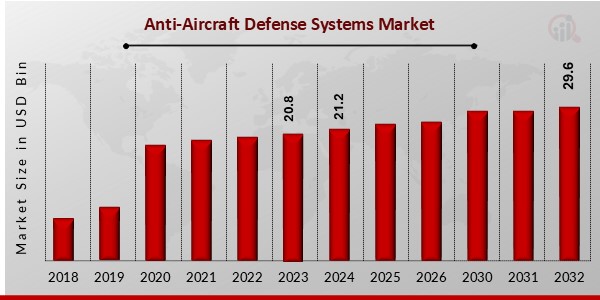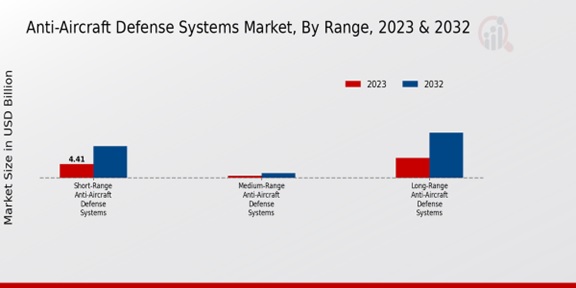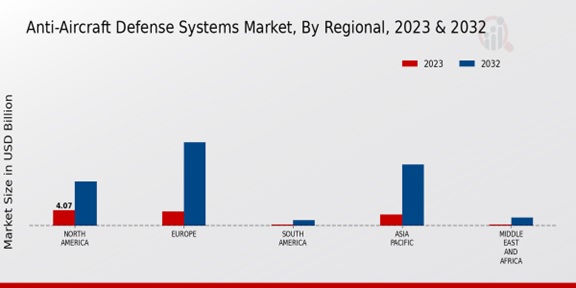Anti-Aircraft Defense Systems Market Overview
Anti-Aircraft Defense Systems Market Size was estimated at 20.8 (USD Billion) in 2023. The Anti-Aircraft Defense Systems Market Industry is expected to grow from 21.2 (USD Billion) in 2024 to 29.6 (USD Billion) by 2032. The Anti-Aircraft Defense Systems Market CAGR (growth rate) is expected to be around 6.5 % during the forecast period (2024 - 2032).

Key Anti-Aircraft Defense Systems Market Trends Highlighted
Advancements in aviation technology, particularly the development of drones and unmanned aerial vehicles (UAVs), have heightened the demand for robust anti-aircraft defense systems. These systems provide critical protection against airborne threats, including surveillance and tracking, early warning, and interception. The growing prevalence of asymmetric warfare and terrorism has further fueled this demand.
The advent of directed energy weapons (DEWs), such as lasers and electromagnetic pulse (EMP) systems, is shaping the future of anti-aircraft defense. DEWs offer potential advantages in terms of speed, precision, and reduced collateral damage. Additionally, the integration of artificial intelligence (AI) and machine learning (ML) algorithms into defense systems is enhancing their target recognition, situational awareness, and decision-making capabilities.
Cybersecurity measures play a vital role in protecting anti-aircraft defense systems from cyberattacks, which can compromise their effectiveness. Advanced encryption technologies, intrusion detection systems, and secure network management are essential components of a comprehensive cybersecurity strategy for these systems.
Source: Primary Research, Secondary Research, MRFR Database and Analyst Review
Anti-Aircraft Defense Systems Market Drivers
- Rising geopolitical tensions and conflicts
The fact that there are many tensions and conflicts across the globe on issues touching different geographical regions is skyrocketing, and the investments in Anti Air defense Systems from different countries. Ukraine is one of the grounds for the high rates of growth of the wars, and the crisis has spread outside the eastern sides in which most of the battles took place. More lands are being condemned daily to battles, and peasantry lives in despicable conditions.The Middle East and Asia Pacific are in the same state, with several other areas affected by the two zones. For instance, we witness the announced plans by Saudi to invest $2 billion in the Anti Air Defense Systems of the country in 2022 to counter the attacks from Yemen, which are using technology in the forms of drones and missiles. India has and is taking a curious GDP growth in the upper direction in connection to investments in Anti-Air Defense systems due to the Wars in its lands by China and Pakistan.
Advancements in technology
The Anti-Aircraft Defense Systems Market Industry is driven by a rapidly advancing technological landscape. New technologies such as artificial intelligence, machine learning, and directed energy weapons are empowering anti-aircraft defense systems to become more effective. For instance, with the increased use of AI, anti-aircraft systems can now automatically detect and track the trajectory of incoming threats. In the same manner, ML can be used to predict the trajectory of missiles and aircraft.Directed energy weapons are weapons that are not projectiles but rather beams of concentrated radiation or particles that can destroy targets without needing to physically touch them. Therefore, they are a neat remedy against drones and other fast-moving, small targets. In conclusion, bearing in mind that all of those technologies and ways of implementation are likely to develop, the Anti-Aircraft Defense Systems Market Industry will only continue to expand.
Increasing demand for homeland security
Apart from that, increasing demand for homeland security also leads to an increase in this market. There are many countries that invest in anti-aircraft defense systems to protect their citizens from terrorist attacks. After the 9/11 attacks, the United States of America invested millions of dollars into the air defense system to protect its cities from terrorist attacks. The same is true with other countries; other countries also spend a lot of money on anti-aircraft defense to protect their critical infrastructure and population centers.
Anti-Aircraft Defense Systems Market Segment Insights:
Anti-Aircraft Defense Systems Market Range Insights
The Anti-Aircraft Defense Systems Market is segmented by range into short-range, medium-range, and long-range systems. Short-range anti-aircraft defense systems are designed to intercept and destroy targets at a range of up to 5 kilometers. Medium-range anti-aircraft defense systems have a range of 5 to 20 kilometers, while long-range anti-aircraft defense systems have a range of over 20 kilometers. The short-range anti-aircraft defense systems segment is expected to witness significant growth over the forecast period, owing to the increasing demand for these systems from developing countries.These systems are relatively inexpensive and easy to operate, making them an attractive option for countries with limited defense budgets. The medium-range anti-aircraft defense systems segment is also expected to witness healthy growth, as these systems offer a greater range and capability than short-range systems. The growth of the market is attributed to the increasing demand for advanced air defense systems from countries around the world. The market is also expected to benefit from the growing adoption of artificial intelligence and other advanced technologies in the development of anti-aircraft defense systems.

Source: Primary Research, Secondary Research, MRFR Database and Analyst Review
Anti-Aircraft Defense Systems Market Mobility Insights
The Anti-Aircraft Defense Systems Market is segmented by Mobility into Static Anti-Aircraft Defense Systems and Mobile Anti-Aircraft Defense Systems. In 2023, the Mobile Anti-Aircraft Defense Systems segment held a larger market share, accounting for over 60% of the global market. This is primarily due to the increasing demand for mobile air defense systems that can be easily deployed and maneuvered to protect critical assets and areas. Mobile Anti-Aircraft Defense Systems offer greater flexibility and agility, making them suitable for various defense applications, including protecting military bases, cities, and strategic infrastructure.The market for Mobile Anti-Aircraft Defense Systems is expected to continue to grow steadily in the coming years, driven by the need for advanced and effective air defense capabilities in modern warfare.
Anti-Aircraft Defense Systems Market Weapon Type Insights
The Anti-Aircraft Defense Systems Market segmentation by Weapon Type includes gun-based, missile-based, and laser-based systems. Missile-based systems hold the largest market share due to their long range, high accuracy, and ability to engage multiple targets simultaneously. Gun-based systems are used for close-range defense and are typically mounted on vehicles or ships. Laser-based systems are still in the early stages of development but offer the potential for high-energy, directed-energy weapons that can disable or destroy aircraft. The Anti-Aircraft Defense Systems Market is expected to reach USD 15.85 billion by 2032, growing at a CAGR of 3.7% from 2023 to 2032.
Anti-Aircraft Defense Systems Market Application Insights
The Anti-Aircraft Defense Systems Market is segmented by Application into Air Defense, Counter-Unmanned Aircraft Systems (C-UAS), Critical Infrastructure Protection, and Border Security. The Air Defense segment is projected to account for the largest share of the market in 2024, owing to the increasing demand for air defense systems to protect against aerial threats. The C-UAS segment is expected to witness significant growth over the forecast period due to the rising concerns over the use of drones for malicious purposes. The Critical Infrastructure Protection segment is also anticipated to grow steadily as governments and organizations focus on safeguarding critical infrastructure from potential attacks.The Border Security segment is expected to experience moderate growth, driven by the need to enhance border security and prevent illegal activities.
Anti-Aircraft Defense Systems Market Regional Insights
The regional segmentation of the Anti-Aircraft Defense Systems Market offers valuable insights into the market's geographical distribution and performance. North America is anticipated to hold a significant market share due to increasing defense spending and technological advancements. Europe is another major market for anti-aircraft defense systems, driven by geopolitical tensions and the need for advanced air defense capabilities. The APAC region is expected to witness substantial growth over the forecast period, primarily driven by rising defense budgets and modernization efforts in countries like China and India.South America and MEA are expected to experience steady growth, influenced by increasing security concerns and investments in air defense systems. This regional segmentation provides key insights for market players to tailor their strategies and target specific regions with high growth potential and specific market requirements.

Source: Primary Research, Secondary Research, MRFR Database and Analyst Review
Anti-Aircraft Defense Systems Market Key Players And Competitive Insights:
The major players in the anti-aircraft defense systems market are trying to enhance their positions through the development of advanced technologies. They invest heavily in research and development to introduce innovative solutions that will meet the constantly changing demands of their customers. Mergers and acquisitions are the frequent strategies employed by the leading players in the Anti-Aircraft Defense Systems Market to extend their product ranges and enter new markets. The Anti-Aircraft Defense Systems Market is characterized by a high level of competition, and a few major players share a substantial part of the market. Therefore, the players in this industry constantly vie with one another for competitive advantage, introducing new products, forming strategic partnerships, and expanding their global presence. The increasing demand for advanced air defense systems is one of the major drivers of the development of the given market. The producers of the anti-aircraft defense systems can use a range of advanced technologies and new materials to create more efficient systems.
The Anti-Aircraft Defense Systems Market Competitive Landscape is defined by the presence of global, established companies and emerging, regional companies. Raytheon Technologies is one of the major players in this market and offers a wide range of air defense solutions. Among the air defense systems manufactured by the company, the Patriot missile system is the most widely deployed in the world. Next-generation air defense systems developed by the company include the Patriot Advanced Capability-3 missile system. Lockheed Martin is one more major player in the AAD system Market with the advanced air defense technologies in its portfolio. The Terminal High Altitude Area Defense system is meant to intercept ballistic missiles at very high altitudes. Another air defense system being developed by the company is the Long-Range Air-to-Air Missile. BAE Systems is a global company that operates in the field of defense. The Air Warfare Systems business unit produces a wide range of air defense systems, such as the Rapier missile system or the Sea Ceptor naval air defense system. The company also invests in the development of new solutions, such as the Sky Sabre air defense.
Key Companies in the Anti-Aircraft Defense Systems Market Include:
- Denel Dynamics
- Diehl Defence
- Rostec
- BAE Systems
- MBDA
- Thales
- Rafael Advanced Defense Systems
- Lockheed Martin
- Raytheon
- Kongsberg Defence Aerospace
- Elbit Systems
- Rheinmetall
- Leonardo DRS
- Northrop Grumman
Anti-Aircraft Defense Systems Market Industry Developments
The Anti-Aircraft Defense Systems Market is projected to reach a value of USD 15.85 billion by 2032, exhibiting a CAGR of 3.7% during the forecast period (2024-2032). Recent developments include the increasing demand for advanced air defense systems due to rising geopolitical tensions and the growing threat of aerial attacks. Key players in the market are investing in the development of next-generation systems with improved capabilities, such as enhanced radar technology and advanced interceptors. Additionally, the adoption of artificial intelligence (AI) and machine learning (ML) in air defense systems is expected to drive market growth in the coming years.
Anti-Aircraft Defense Systems Market Segmentation Insights
Anti-Aircraft Defense Systems Market Range Outlook
- Short-range Anti-Aircraft Defense Systems
- Medium-range Anti-Aircraft Defense Systems
- Long-range Anti-Aircraft Defense Systems
Anti-Aircraft Defense Systems Market Mobility Outlook
- Static Anti-Aircraft Defense Systems
- Mobile Anti-Aircraft Defense Systems
Anti-Aircraft Defense Systems Market Weapon Type Outlook
- Gun-based Anti-Aircraft Defense Systems
- Missile-based Anti-Aircraft Defense Systems
- Laser-based Anti-Aircraft Defense Systems
Anti-Aircraft Defense Systems Market Application Outlook
- Air Defense
- Counter-Unmanned Aircraft Systems (C-UAS)
- Critical Infrastructure Protection
- Border Security
Anti-Aircraft Defense Systems Market Regional Outlook
- North America
- Europe
- South America
- Asia Pacific
- Middle East and Africa
| Report Attribute/Metric |
Details |
| Market Size 2023 |
20.8 (USD Billion) |
| Market Size 2024 |
21.2 (USD Billion) |
| Market Size 2032 |
29.6 (USD Billion) |
| Compound Annual Growth Rate (CAGR) |
6.5% (2024 - 2032) |
| Report Coverage |
Revenue Forecast, Competitive Landscape, Growth Factors, and Trends |
| Base Year |
2023 |
| Market Forecast Period |
2024 - 2032 |
| Historical Data |
2019 - 2023 |
| Market Forecast Units |
USD Billion |
| Key Companies Profiled |
Denel Dynamics, Diehl Defence, Rostec, BAE Systems, MBDA, Thales, Rafael Advanced Defense Systems, Lockheed Martin, Raytheon, Kongsberg Defence Aerospace, Elbit Systems, Rheinmetall, Leonardo DRS, Northrop Grumman |
| Segments Covered |
Range, Mobility, Weapon Type, Application, Regional |
| Key Market Opportunities |
Proliferation of unmanned aerial vehicles UAVs Modernization of existing defense systems Growing concerns over aerial threats Technological advancements in antiaircraft systems Increased military spending |
| Key Market Dynamics |
1 Increased demand from emerging countries2 Growing threat of aerial attacks3 Technological advancements in antiaircraft systems4 Increasing defense budgets5 Collaborations and partnerships |
| Countries Covered |
North America, Europe, APAC, South America, MEA |
Frequently Asked Questions (FAQ) :
The Anti-Aircraft Defense Systems Market is valued at approximately USD 20.8 billion in 2023 and is projected to reach USD 29.6 billion by 2032, exhibiting a CAGR of 6.5% during the forecast period.
North America is the dominant region in the Anti-Aircraft Defense Systems Market, accounting for a significant market share. The region's advanced defense capabilities, technological advancements, and high military spending contribute to its leading position.
The increasing geopolitical tensions, advancements in aerial warfare capabilities, and rising defense budgets worldwide are the primary growth drivers propelling the Anti-Aircraft Defense Systems Market. Additionally, technological advancements, such as the integration of artificial intelligence (AI) and directed energy weapons, are further fueling market growth.
Anti-Aircraft Defense Systems find applications in various defense domains, including protection against aerial threats such as aircraft, drones, and missiles. They are deployed to safeguard critical infrastructure, military bases, and urban areas from air attacks.
The Anti-Aircraft Defense Systems Market is characterized by the presence of established players and emerging companies. Key competitors include Lockheed Martin, Raytheon Technologies, BAE Systems, Thales Group, and MBDA. These companies offer a range of anti-aircraft defense solutions, including missile systems, radar systems, and integrated air defense networks.
The Anti-Aircraft Defense Systems Market faces certain challenges, including the rapid evolution of aerial threats, the need for continuous technological upgrades, and stringent regulatory compliance requirements. Additionally, budget constraints and geopolitical factors can impact market growth in certain regions.
The Anti-Aircraft Defense Systems Market is anticipated to exhibit a steady growth rate over the forecast period, with a CAGR of 6.5 % from 2024 to 2032. This growth is driven by the increasing demand for advanced defense systems and the ongoing modernization efforts by armed forces worldwide.
The Anti-Aircraft Defense Systems Market is witnessing several emerging trends, including the development of directed energy weapons, the integration of artificial intelligence (AI), and the growing adoption of networked defense systems. These advancements are transforming the capabilities of anti-aircraft defense systems and enhancing their effectiveness against evolving aerial threats.
New entrants in the Anti-Aircraft Defense Systems Market can explore opportunities in niche segments, such as the development of specialized systems for countering specific aerial threats or offering cost-effective solutions for emerging markets. Collaboration with established players or focusing on technological differentiation can also provide opportunities for new entrants to gain a foothold in the market.
The COVID-19 pandemic had a limited impact on the Anti-Aircraft Defense Systems Market. While initial disruptions in supply chains and production schedules were observed, the market quickly adapted to the new operating environment. Defense spending remained stable or even increased in many countries as governments prioritized national security amidst the global crisis.

















